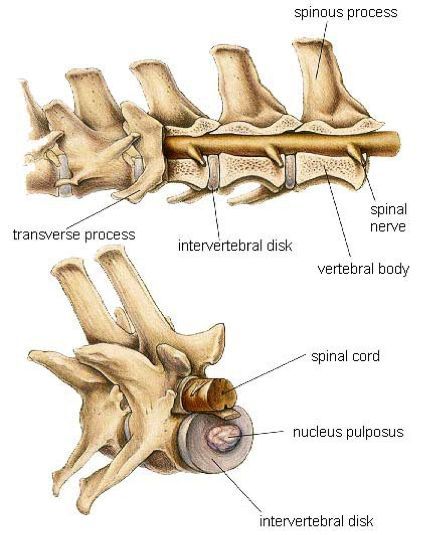Your dog will have an inability to walk and will also be lacking deep pain response. While less commonly seen disc disease in the lower back can lead symptoms such as pain or difficulty jumping a limp tail or urinaryfecal incontinence.

Double P Ii Herbal Blend Helps Dogs With Ivdd Dogs Herbal Blends Herbalism
Some of the most common symptoms of a slipped disc in dogs include.

Dog disk disease. This is also known as a slipped disc. Abnormal gait or movement Appearing tight or guarded around the abdomen and back often with a hunched appearance Being reluctant to participate in physical activities Appearing uncoordinated or. This rupture leads to damage to the spinal cord.
However both types of IVDD result in the compression of the spinal cord and can. In healthy dogs the disc material between the spinal vertebrae acts like shock absorbers in. The majority of cases especially when treated early will.
Disc disease is a common problem in dogs and relatively uncommon in cats. This is rare but very serious when it does occur. Dogs within the age range of 3 to 7 are more prone to developing degenerative disc disease but long low-slung dogs are those that are particularly prone to getting it as well as some other types of back problems.
The longer a dog suffers from severe IVDD the worse the chances of full recovery become. One type is a much slower degenerative process than the other. Intervertebral Disk Disease IVDD in Dogs - Veterinary Partner - VIN.
Intervertebral Disc Disease IVDD Intervertebral disk disease IVDD is a term for degeneration and protrusion of the intervertebral disk in dogs which leads to. With proper attention many dogs with this painful and debilitating condition can recover to a comfortable and more active lifestyle. This common condition can be seen in any breed but is particularly common in long-backed breeds which tend to gain weight such as Dachshunds Beagles and Bassett Hounds to name just a few.
There are two types of disease that can afflict the intervertebral disk causing the disk to press painfully against the spinal cord. Type II which is characterized by the protrusion of the disc is more common in larger breeds of dogs. There are two types of intervertebral disc disease IVDD.
Dogs that have a long back and short legs are more at risk for this type of IVDD. The condition can also be hereditary. The first type 1 is characterized by rupture of the middle part of the disc the nucleus pulposus through tears in the outer part of the disc the annulus fibrosis.
This disease affects the cushioning discs located between the vertebrae bones of your dogs spine. Type I disc disease is characterized by disc herniation slipped disc and a sudden onset of signs. Symptoms will vary depending on which part of your dogs spine is impacted but can include.
Dog back pain can be a gut-wrenching experience for you and your fur baby and unfortunately intervertebral disc disease IVDD is a pretty common problem with dogs. There are two major categories of disc disease Type I and Type II. Symptoms of IVDD in dogs may include.
One of the most painful and frustrating diseases to treat in dogs is degenerative disc disease. This type of disc disease occurs in dogs and cats of any age or breed but is seen most commonly in short-legged breeds eg dachshund bassett. What happens in dogs with intervertebral disc disease.
There are two types of intervertebral disc disease explains Dr. Usually affects rear limbs first Dragging one or more limbs Tucked abdomenhunched back Lowered head andor difficulty turning the head especially if the issue is in the neck Reluctance or. Type I is characterized by the extrusion of the disc.
Stiffness of the neck Back pain Crying when handled or picked up Shivering Reluctance to run or play Inability to walk or a peculiar gait Paralysis Paresis partial loss of movement or weakness. Intervertebral disk disease IVDD is the most common cause of spinal cord injury in dogs. Paralysis Abnormal walking Unwillingness to jump Pain and weakness in rear legs lameness Crying out in pain Anxious behavior Hunched back or neck with tense muscles Reduced appetite and activity level Loss of bladder andor bowel control urinary and fecal.
Symptoms Lameness or Drunken gait ataxia Stepping on the wrong side of the paw feet flipped over.

Your Active Dog Was Diagnosed With Intervertebral Disk Disease Now What Dog Activities Puppies Gif Paralyzed Dog

Ivdd Awareness Quick Reference Info Know The Signs Of Ivdd Dachshund Awareness Dachshund Silhouette

New Advances In Genetics And Disc Disease In Dogs Disease Genetics Risk Factors

Wobbler Syndrome In Dogs Weebles May Wobble But Dogs Shouldn T Intervertebral Disc Vet Medicine Vets

Dodgerslist Canine Back Problems All Things Ivdd More Info And Support At Http Www Dodgerslist Com Vet Help Disabled Dog Dogs

Hunderassen Die Von Bandscheibenerkrankungen Bei Hunden Betroffen Sind Bandscheibenerkrankungen Betroffen Intervertebral Disc Dachshund Pets Meds For Dogs

The Early Warning Signs Of Ivdd In 2021 Dachshund Dog Care Dog Ramp

Intervertebral Disc Disease Ivdd In Dogs What To Expect Dogs Dauchshund Intervertebral Disc

Intervertebral Disk Disease Ivdd In Dogs Causes Prevention Intervertebral Disc Prevention Dogs

Dog Anatomy Dogs Knee Joint Anatomy

Vet Talks Intervertebral Disc Disease Ivd In Dogs Bulldog Breeds Dogs Pet Breeds

Warning Signs Of Back Problem In Dachshunds Anatomy Of Dachshunds Spine Symptoms Of Intervertebral Disc Disease Dog Health Problems Dachshund Breed Dachshund







